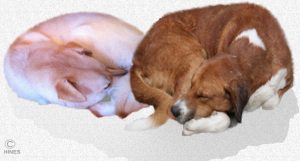Care Of Your Hypothyroid Dog
Ron Hines DVM PhD
 Meds that can interfere with thyroid tests
Meds that can interfere with thyroid tests
What Does It Mean When My Dog Is Hypothyroid?
Your dog’s thyroid gland normally produces two hormones, T3 and T4, that accelerate metabolic processes throughout its body. A sluggish thyroid gland (hypothyroidism) does not produce enough of those hormones. This problem is the most common hormone deficiency experienced by dogs. Dogs that develop the problem, usually start showing signs when they are 4-6 years old. Male and female dogs are equally affected. Spayed and neutered dogs are more susceptible to hypothyroidism than intact pets. (read here & here) You might wonder why that might be. Try to envision a dog’s entire endocrine gland system as being somewhat like an orchestra – each gland being a musical instrument and its musician. When one instrument/gland (such as the ovaries or testicles) are silenced/removed, the entire symphony is negatively affected in a number of ways. Cues from one instrument to another are lost, other musicians play overtime and louder to pick up the slack. Some take up roles they are unsuited for.
Hypothyroidism probably occurs in one dog and not in another because of a combination of lifestyle, the endocrine dysfunction I just mentioned and inborn genetic susceptibility. Breeds including setters, old English sheepdogs, American pit bulls, boxers, beagles, Maltese, dalmatians, cocker spaniels and golden retrievers all rank in the top 20 in breed susceptibility. In some of the cases, veterinarians know that three genes located on your dog’s chromosome 12 are involved. (read here)
Your dog’s thyroid gland consists of two small lobes located near the underside of its neck. The active hormone this gland produces is T3 (triiodothyronine). Your dog’s thyroid gland also produces thyroxine or T4. It produces more T4 than T3. So, your dog’s body must convert T4 into T3 before it can be utilized. It is only T3 that has the ability to regulate your dog’s metabolic rate. Metabolic rate is the rate at which it burns calories for energy and manufactures proteins and carbohydrates from ingested nutrients. Think of it somewhat like the gasoline supply to your car engine. When you press down on the accelerator, the car has more power and goes faster. When the thyroid gland releases more T3, the dog’s body does its metabolic work more diligently.
What Happens If My Dog’s Thyroid Gland Doesn’t Produce Enough T3 and Thyroxine?
It is common for pets with hypothyroidism to gain weight while only eating moderately. These dogs have been described as “easy keepers” because they gain weight so easily. The slower metabolic rate of hypothyroid dogs just does not consume enough calories. What is left over accumulates as fat.
That does not mean that most overweight dogs have thyroid disease. Most fat dogs are just eating too much, eating too rich a diet and get too little exercise. Many owners are oblivious to weight gain in their pets. But when an animal’s backs become flattened instead of curved, and they huff and puff with every exertion, some owners will eventually bring them to their vet for a check-up. You can read more about solutions for chubby dogs here.
When owners bring me these pets, I run thyroid tests on all of them. The most important tests are the pet’s T4 and Free T-4 level – the levels of total thyroxine and free or active thyroxine in their blood.
How Did My Dog Become Hypothyroid?
Most cases of hypothyroidism are caused by the dog’s own immune system attacking its own thyroid gland tissue. This condition is called autoimmune thyroiditis (an anti-thyroid antibody test can be used to confirm this). This type of hypothyroidism is further broken down into two types, lymphocytic thyroiditis and idiopathic thyroid atrophy. In many ways, this problem in dogs is similar to the thyroid problems that occur in humans. You can read about that here. In both cases, the gland fails to produce enough of the hormone, thyroxine. It really is not that important to know which type your pet has because the signs and treatment are the same. We know that genetics plays an important role in this disease. (read here) That is why hypothyroid dogs and close relatives of hypothyroid dogs should never be bred. Occasionally, a puppy will be born a dwarf. Read about that here. It is not that unusual for smaller-than-normal puppies to have been born with hypothyroidism – although there are many other explanations for remaining small. It is also one of the few situations where cats, as well as dogs, suffer from hypothyroidism. (read here)
What Changes Might I See In My Dog’s Skin And Hair Coat?
Dogs need an adequate level of thyroid hormones to maintain normal skin and thick hair coats. When thyroid hormone levels are low, hair grows very slowly – particularly over the lumbar area – equally thin on both sides (=bilaterally symmetrical). The back of their rear legs is also commonly balding.
The pet’s hair coat is often scurfy, flaky and dull. The coat often lacks finer body hairs and undercoat. Your pet’s tail may become as bald as a rat’s tail. An important clue pointing to thyroid deficiency is that this hair loss is not itchy as it would be if the pet had fleas, allergic-skin or infectious skin disease. Occasionally veterinarians or pet owners notice that an area, shaven in anticipation of surgery takes excessively long to regrow hair. That can be one sign of hypothyroidism; but there are rare disease of dogs such as alopecia X that can also be the cause. Read about that problem here.
Hypothyroid dogs commonly have excess black pigment in the skin of their groin. This pigment results in a condition similar to one that occurs in humans for other reasons, acanthosis nigricans. Sometimes this pigment is present over much of the body and the skin becomes oily and thickened. Broken toenails (claws) and claw infections are also common in hypothyroidism. Your pet’s hair coat color might also change.
Can Hypothyroidism Affect My Dog’s Reproductive Ability And Fertility?
Yes.
Female dogs with hypothyroidism often cycle erratically and fail to get pregnant. When they do, they often have small liters or miscarry. Hypothyroidism also negatively affects male fertility. Male hypothyroid dogs may have low sperm counts and decreased libido. Pseudopregnancy or false pregnancy with milk flow and abdominal distension is common in hypothyroid dogs (especially dachshunds).
Treat hypothyroidism for the health benefits your pet will gain. But never for the purpose of breeding.
Are There Other Signs Of Hypothyroidism I Might Recognize?
Yes.
Your pet might not act as bright as it once did. Hypothyroidism negatively affects mental alertness and the ability to learn. If your dog is unusually young when it develops memory lapses, you might ask that a bile acids test and a T4 test be included in its blood work panel. Liver issues as well as hypothyroidism can mimic age related mental decline (CDS).
A slow heart rate, constipation, anemia, muscle weakness and atrophy, nerve disturbances, edema, stunted growth, and slowed clotting of the blood can also be signs of hypothyroidism.
Hypothyroid dogs have more than their fair share of joint pain and swelling. They also have more than their fair share of ear and skin infections. You can read about ear infections in general here. Lazy behavior – such as increased sleeping, less play activity and easy fatigue might also indicate thyroid disease. It has also been reported that hypothyroid dogs have more “dry eye” disease (keratoconjunctivitis sicca).
You might also notice that your dog is more sensitive to cold and chilly weather than it once was. I have never had a dog owner describe that – but it is generally accepted in the veterinary profession.
What Tests Can My Vet Run On My Pet To Diagnose Hypothyroidism?
Laboratories that all veterinarians in the United States have access to offer a blood Thyroid Profile. Some veterinarians include portions of this test in their yearly “wellness” blood screens or begin to include them when your dog get older.
In dogs with hypothyroidism, blood entering a syringe might be a bit creamy whitish and pink in color due to the presence of large amounts of fat (triglycerides and cholesterol). But that can also be due to a recent meal.
Thyroid Panels includes tests to determine the level of three forms of thyroid hormone (T-4, free T-4 and T-3 as well as TSH). Read more about those panels here. Some veterinarians will follow up with the thyroglobin autoantibody test I mentioned earlier to determine if autoimmune thyroid disease is the underlying problem.
It is very important to understand that other health issues in your pet can cause its thyroid test results to be low. T3 and T4 are often low in diseases that affect the entire body – even when the thyroid gland is not the source of the problem. So, before treatment is begun, the pet’s general health needs to be thoroughly examined.
One must be cautious in diagnosing hypothyroidism in sight hounds (greyhounds, Italian greyhounds, whippets, salukis). These breeds seem to naturally have lower thyroid hormone levels than other dog breeds.
What Medications Are Available To Help My Pet?
Fortunately, synthetic thyroid hormone is available in inexpensive tablet form. Unlike many medications, it does not taste bad. The one most commonly dispensed is levothyroxine sodium. All dogs need their dose individually tailored to their needs. Signs that the initial dose may be too high include agitation, excessive thirst, and diarrhea. When those symptoms occur the dose needs to be lowered. Many vets check the pet’s T-4 levels thirty days or so after beginning treatment to be sure the level is adequate. If not, the dose might need to be increased. Periodic retests, perhaps every six months, might be prudent. Once a dog is placed on medication, it will probably be given for the rest of the pet’s life. Over time, it is quite likely that your dog’s dose will need to be adjusted. Each veterinarian has their own opinion as to dose and treatment plan. We all base our treatment plans on what worked best for us in the past.
When the disease is diagnosed early and treated faithfully, you can expect your pet to live a long and happy life
You are on the Vetspace animal health website
Visiting the products that you see displayed on this website help pay the cost of keeping these articles on the Internet.

